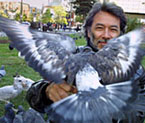Headliners: Broken bones, battered noses and a bird's best friend
Headliners: Broken bones, battered noses and a bird's best friend McGill University
User Tools (skip):
Headliners
Broken bones, battered noses and a bird's best friend
Fractured confidence in antidepressants?
One of the most widely covered research stories in recent weeks was a McGill-based study that links antidepressants to increased risk of bone fractures in adults. Led by David Goltzman, Director of the Royal Vic's Calcium Research Laboratory, the five-year study followed 137 patients over the age of 65 who were taking commonly used antidepressants known as selective serotonin reuptake inhibitors, or SSRIs. As reported by the Washington Post, the New York Times, ABC News and CTV, Goltzman's work suggests that daily use of SSRIs is associated with both a decrease in bone mineral density and an increased risk of falling. In all, patients on SSRIs had double the risk of fractures, especially of the forearm, ankle and foot.
Media in the media glare

Claudio Calligaris
Nothing gets the media a-twitter quite like a story about the media. The proposed $2.3-billion sale of Alliance Atlantis Communications to Winnipeg-based CanWest Global Communications and Goldman Sachs Group, a prominent investment bank based in the U.S., has caused media types to beat a path to Marc Raboy's door looking for some expert insight. Quoted in separate articles in both the Globe and Mail and the New York Times, the Beaverbrook Chair in Ethics, Media and Communication said that the proposed deal is a "precedent-setting case" for the Canadian Radio-television and Telecommunications Commission (CRTC). At the heart of the controversy is the deal's structure that sees Goldman Sachs footing almost the entire bill of the acquisition — a potentially troublesome detail in light of the CRTC's laws banning the foreign control of broadcasters.
And in the ladies' corner...

Courtesy of McGill Athletics
And now one from the But Is It Progress? Department. An article in the Ottawa Sun said that the bigwigs of Ultimate Fighting mixed martial arts franchise are patting themselves on the back for increased interest for their sport among women. Apparently, all it took was some clever marketing; put the buff guys in skimpy lycra shorts, eliminate the eye-gouging and women will flock to the events. Gordon Bloom, a professor of sports psychology says that it goes a little deeper than that, with more and more women being drawn to contact sports both as fans and participants. "At least in North America, it's no longer a bad thing for women to be associated with aggressive and violent sports," he said. "And not only are they playing it, they are starting to play it a lot like men."
Bigger is indeed better

Owen Egan
Before you decide to put someone in their place by calling them a birdbrain, perhaps you should do a little research into exactly what kind of bird you mean. As reported in Scientific American and the Montreal Gazette, a recent study by Biology Professor Louis Lefebvre suggests that the bigger a bird's brain, the better their chances of survival. Citing the cognitive buffer hypothesis, Lefebvre contended that "in any risky situation you encounter, if you have the brains to use innovativeness or learning to cope... you might be able to avoid death by starvation or predation." The study found that birds with higher brain-to-body ratios, like cockatoo parrots, had significantly lower mortality rates than their cerebrally challenged counterparts like pheasants. So why the squadrons of pea-brained pigeons in the downtown core?

